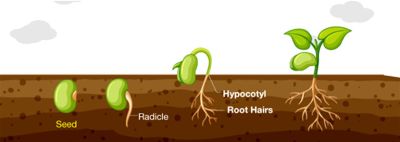Germination
Germination is a process of growth of a plant species from its seed. A classic example of this can be the sprouting of a seedling from an angiosperm or gymnosperm seed. Seed germination process generally involves three major phases. In the first stage, the seed coat gets swollen and softened following the rapid water absorption of seed. As a result, the seed activates its internal physiology, begins its respiration process, breaks down the stored food in metabolism, and produces proteins. The next phase, 2nd stage, includes the emergence of a radicle by rupturing softened seed coat and the formation of primary root which facilitates water uptake from underground. After the radicle and plumule from the seed appear, its shoot starts growing upwards towards the surface. Lastly, the final stage of the germination process ends at when the cells become metabolically active enough to elongate and divide for the seedling to grow further.

Water is a necessity for a seed to germinate. During the process, it softens and ruptures the seed coat, increases the seed permeability, provides dissolved oxygen for the embryo, and supplies required hydration for the vital protoplasmic activities. Moreover, it also aids in dissolving insoluble food for the translocation of soluble forms to the embryo. Oxygen in the pores of soil particles is a vital source of energy required for the seed growth. It is essential for the metabolism of the germinating seed and is used as a part of aerobic respiration until the seed starts growing its own green leaves. Temperature is another important component for seed germination, which typically requires 25-30°C. It is a fact that different temperatures are optimal for the germination of different types of seeds. Light is important to trigger the germination of many seeds, which do not undergo the process until they receive sufficient sun light. [Md. Jashim Uddin]
